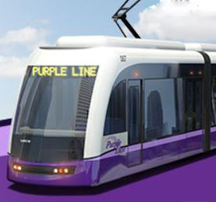Thrive 2050
Letter to County Council, October 23, 2021
The Action Committee for Transit (ACT) strongly supports the Thrive Montgomery 2050 general plan and its vision for land use, transportation, environmental protection, and housing equity. If we want to improve housing, racial equity, and our local economy, Montgomery County must move on from the outdated, car-dependent, “wedges and corridors” model of the past. We need to embrace a more sustainable, inclusive, and transit-oriented vision for the future. Thrive 2050 offers that vision.
Montgomery County faces a staggering shortage of housing over the next decade, both subsidized and market-rate. The Urban Institute estimates that our region needs at least 374,000 new housing units by 2030. The Metropolitan Washington Council of Government predicts over 208,000 new residents of Montgomery County alone by 2045. Home prices have jumped more than 13.5% just since 2020, with the median price of a home in Montgomery County being more than $550,000. That is neither sustainable nor affordable. Without intervention to address this shortage, housing costs will continue to rise, economic growth will continue to stagnate, and traffic will continue to plague our region.
The reason for this shortage is obvious: we don’t have enough homes. According to the National Capital Region Transportation Planning Board (TPB) at the Metropolitan Washington Council of Governments (COG), more than 325,000 workers commute to jobs each day from communities located outside our region. Our lack of housing – particularly affordable housing – drives workers and families to leave Montgomery County just to find housing they can afford. This situation increases everyone’s commute times, undercuts Montgomery County’s appeal to new businesses, negatively affects our environment, and detracts from everyone’s quality of life.
ACT believes that we cannot adequately address these transportation and equity issues in our community without addressing land use and transportation. The Thrive Montgomery 2050 General Plan moves us toward addressing the housing shortage and discriminatory land-use in Montgomery County, while also refocusing our transportation policy on transit and adopting a more transit-oriented approach to development. Thrive 2050’s Affordable and Attainable Housing section calls for “more of everything.” That is exactly what our county must have just to keep pace with population growth, much less address equity, affordability, and economic need. The Thrive 2050 transportation section focuses on building a “world-class” transit system, developing an “irresistible” network for walking and biking, and reducing our dependence on cars, all things we desperately need.
To stay competitive, to become sustainable, to achieve equity, to improve transit, Montgomery must embrace the vision of Thrive 2050.
Paul Goldman
Action Committee for Transit

